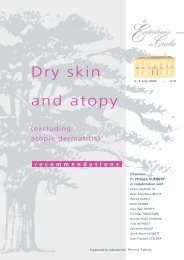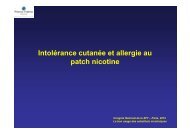Nicotine replacement therapy … - Carlos A ... - Entretiens du Carla
Nicotine replacement therapy … - Carlos A ... - Entretiens du Carla
Nicotine replacement therapy … - Carlos A ... - Entretiens du Carla
Create successful ePaper yourself
Turn your PDF publications into a flip-book with our unique Google optimized e-Paper software.
• Other studies have demonstrated the<br />
value of re<strong>du</strong>cing consumption in patients<br />
with COPD ("Lung Health Study") to<br />
enable them to maintain abstinence by<br />
consuming 2-mg gum with 5 years of<br />
follow-up (14% of ex-smokers out of 3,923<br />
patients consumed 10 pieces of gum a<br />
day) or to pro<strong>du</strong>ce long-term smoking<br />
re<strong>du</strong>ction (5% of resi<strong>du</strong>al smokers<br />
consumed 7 pieces of gum a day) (20). In<br />
both cases perfect coronary tolerance was<br />
observed, while re<strong>du</strong>ced breath CO levels<br />
correlated with the decrease in the<br />
number of cigarettes consumed. During<br />
the follow-up of this study it was observed<br />
that repeated quit attempts re<strong>du</strong>ced loss<br />
of lung function, as assessed by FEV1 (21).<br />
An NRT-assisted smoking re<strong>du</strong>ction<br />
strategy in patients with asthma pro<strong>du</strong>ced<br />
slight clinical improvement but above all<br />
increased motivation to quit smoking [22].<br />
In subjects smoking more than 40<br />
cigarettes a day and agreeing to take part<br />
in a re<strong>du</strong>ction strategy with the assistance<br />
of 2-mg strength gum (10/day) for 9 weeks<br />
and to undergo endoscopic investigations<br />
(23) it was shown that smoking re<strong>du</strong>ction<br />
could be obtained in 13 of the 15<br />
volunteers, that is was accompanied by a<br />
44% re<strong>du</strong>ction in mean exhaled CO levels<br />
and that improvements in endoscopic<br />
measures of bronchoalveolar inflammation<br />
(biochemical and cellular) were rapidly<br />
shown.<br />
Fleur Van Bladeren.<br />
Many studies stress its<br />
safety<br />
The observations from the "Lung<br />
Health Study" cited above (20) and those<br />
from the study by Mahmarian et al. (24)<br />
where smokers with coronary artery<br />
disease were given high doses of nicotine<br />
<strong>replacement</strong> <strong>therapy</strong> showed that<br />
ischemia is not exacerbated by NRT (the<br />
degree of ischemia correlated with toxic<br />
carbon monoxide intake). Finally, NRTsupported<br />
smoking re<strong>du</strong>ction is associated<br />
with improvements in indicators of<br />
hemodynamic, metabolic and biometric<br />
risk which, combined with the<br />
improvement in quality of life indicators<br />
(25), suggest that this technique is safe.<br />
Although studies need to be developed<br />
in order to identify all the biomarkers of<br />
harm and their impact on health (26-27)<br />
NRT is currently the effective <strong>therapy</strong> to<br />
help smoking cessation in smoking<br />
re<strong>du</strong>ction strategies that has been best<br />
evaluated and that presents the highest<br />
benefit/risk profile (28-29).<br />
Question on<br />
hold and future<br />
perspectives<br />
Is smoking re<strong>du</strong>ction<br />
using OTC NRT<br />
conceivable?<br />
One study (30) con<strong>du</strong>cted in 223<br />
smokers receiving treatment with 21-mg<br />
patches for 42 days simply with the<br />
support of a self-help manual found a 6month<br />
quit rate of 12% and a quit<br />
attempt rate of 22% (identical rates to those<br />
observed after 6 weeks). Of those smoking<br />
after 6 months, mean daily consumption had<br />
decreased from 28 to 18 cigarettes.<br />
Therefore, smoking re<strong>du</strong>ction supported by<br />
OTC NRT would be possible…<br />
52






